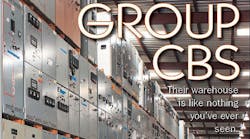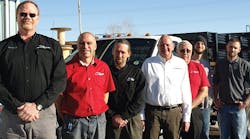Kennedy Electrical Supply's new switchgear division positions the company as a one-stop source of supply for large project work in the Big Apple.
Close your eyes for a few seconds and conjure up a stereotype of a New York City electrical contractor. How close do you come to this person? A street-smart wise-guy yapping a-mile-a-minute in a thick Brooklyn accent on a cell phone-with one hand on an overloaded pastrami-and-rye, and the other hand on the wheel of a graffiti-splattered delivery van, maneuvering past a triple-parked cab in a no-parking zone during rush hour traffic.
The folks at Kennedy Electrical Supply don't have to stretch their imaginations too much to come up with this character. He and his brethren have been strolling through the doors of the counter area of the company's headquarters on Merrick Blvd. in the Queens Borough of New York City for over 30 years.
Over the past two years, the 80-employee electrical distributorship has offered a new service to these customers, as well as others in metropolitan New York. Kennedy Power Systems, its three-person switchgear department founded in 1997, provides medium-voltage switchgear equipment such as large power transformers, network protectors, collector bus, SCADA systems and panelboards for large construction jobs and retrofit work for New York's airports, transit system, office and residential towers, dormitories, hospitals and other commercial and institutional facilities. Among other projects, the company is currently working with S.N. Tannor, Inc. on the installation of a power system to serve the electrical system of a park across from New York's city hall.
New York's huge construction market is hot right now, but it's not a world that just anyone can jump right into. It takes years to develop the contacts at the various city and state agencies doing much of the work, as well as with distributors' traditional customers and buying influences in the construction community such as electrical contractors, general contractors, specifying engineers and electrical inspectors.
"When you look at how business gets done in New York, you see that it's very segmented," says Greg Griswold, the company's vice president and general manager. "You have Transit, Port Authority, Department of Environmental Protection (DEP), Dormitory Authority, School Authority, Housing Authority, and every one of them has different rules. In addition to the public work, there is the commercial market, and projects such as Trump Towers."
The jobs range in size from the millions of dollars, as is the case with a huge contract the company is now working on for terminal construction at Kennedy Airport, to smaller orders sold along with Kennedy Electrical Supply's traditional product offering. "You could have 100 panels that are fairly simple, but it's a $50,000 job," says Griswold. "That's a big job, but you could have one transformer that's small dollar-wise, but is complex and we would not stock it. It depends on how you break them up. The stuff we typically are dealing with here is in the subterranean basement. Nobody ever sees it, but it's the most important stuff going into the building. The wire and the fixtures don't operate unless we have that stuff in."
The traditional pipe-and-wire business that the company has done for years is a different world, he says, but the two markets sometimes feed work to each other. "It's very complicated. A guy just doesn't fax over an order for a lift of pipe, you deliver it the next day, and you are done. You look at the plans and specs, do a takeoff and give him a bill of materials and negotiate a price. Then you get the privilege of giving him drawings of what you are going to give him and then you go through the approval process. From when you start on something to when you deliver it could take six months to a year. It's a much more long-term investment from our standpoint."
Hiring Charlie Colella, a former GE Distribution & Control salesperson in the New York market, as manager of the new department helped get it off to a quick start because Colella understood the dynamics of the local marketplace. It's the nature of the beast when selling switchgear to invest a lot of time upfront for future payoffs down the road, says Griswold.
IBEW Local 3 Influence
You can't get very far into any story on selling switchgear in the New York market without learning about the influence of the International Brotherhood of Electrical Workers (IBEW) Local 3. With the possible exception of Chicago, New York's electrical business is the most heavily unionized in the U.S. Electrical contractors are all unionized, as are the truck drivers and warehouse workers of electrical supply houses. Tales of what happens to nonunion companies that try to work on union jobs in New York are legend in the local construction community.
In New York, even the switchgear must be "Local 3 manufactured." One of the requirements of this approval is that the equipment must be manufactured in the U.S. Because some components in the products of the major switchgear manufacturers-Cutler-Hammer/Westing-house, Pittsburgh, Pa.; GE Distribution and Control, Inc., Plainville, Conn.; and Siemens Energy & Automation, Inc., Alpharetta, Ga.-are either made offshore or manufactured using robots, Local 3 looks to other sources. Switch-gear specialists based in the New York area (also called "builders") including Delta Metal Products, Mac Power and Metropolitan build this equipment to a more stringent New York City Electrical Code. These companies occasionally use some components made by what this market calls the "national manufacturers"-Cutler-Hammer, GE and Siemens.
"There are about eight (switchgear) builders, and three or four big ones," explains Colella. "They will do a job like the Chrysler building, and do all of the panelboards and switchboards for the contractor. The contractor will look to them for the product, and not as much to Cutler-Hammer, GE or Siemens. They will pay a premium to buy from that local builder.
"When they build lighting panels, they may use GE components and Cutler-Hammer breakers, but they form their own busbars, and build their own box," he continues. "Part of that's driven by the code. But a lot of it is driven by the IBEW-having local content and being union-made. Nationals are typically nonunion. New York is a pretty unique place when it comes to those kinds of things. The local builders do a good job and serve the marketplace well. But I think the timing is right to add another level of service."
One of the reasons Kennedy Electrical Supply got into the switchgear business was to offer customers a one-stop source of supply for both national and local builders, while providing the engineering and project management expertise to ensure that the job complies with the New York City Electrical Code and is delivered properly.
"The market was ready for something like this," says Colella. "The manufacturers keep cutting back on staff and support, so someone needed to fill in the gap. The Local 3 builders do an excellent job, and good, bad or indifferent, they set the level of service here in the metro area. When customers do a job with a national like a Cutler-Hammer or GE, they measure them against the same service level, and sometimes they don't match up. That's where we try to fill in the gap."
Colella says the value-added services that Kennedy Power Systems provides include catching problems before they develop by having a third set of eyes checking the drawings to ensure that the equipment will meet New York electrical codes.
"The nationals like to build everything in black-and-white to the National Electrical Code," he says. "That's fine, and most of the time that has application here. But there are times when it just doesn't apply. That's where we try to fill in the gap. We say, 'Listen. This does not meet the code for New York City. You need to change this or beef this up.' That's where we try to add some more value."
Since Kennedy Power Systems is not tied solely to one of the major switchgear manufacturers it can also offer advice on which manufacturer's equipment works best for a particular application, says Griswold.
"The manufacturers want us to go single-line, but we tell them, 'Look at the marketplace. If you cannot truly service this market 100%, we need to have someone else here because we are a full-service distributor,'" adds Colella. "GE may be good at Port Authority-type stuff, Siemens. might be good at transit, and Cutler-Hammer might be good at dormitory stuff. Some of them can't do the different agencies."
Another value-added service that Kennedy Power Systems offers is job-site delivery under the most demanding circumstances. Kennedy Electrical Supply runs a fleet of trucks in the city and surrounding area, and recently added a boom truck for tricky unloading situations. Griswold is particularly proud of the boom truck, which he says separates Kennedy Electrical Supply from the pack because it is the only distributor in the city with this equipment. "That has helped us out when some manufacturers can't deliver and there is a requirement for a lift gate, self unloading or union drivers. We have all that, and have come in to unload the equipment for manufacturers. We do night deliveries, and Saturday and Sunday deliveries. In the middle of Manhattan, a lot of times you can only deliver at midnight or on a Saturday when you can get access to the freight elevator. You have to understand that stuff in this marketplace."
Going Smaller to Get Bigger
While the bulk of Kennedy Power Systems' business to date has been with custom-built switchgear, the switchgear division is starting to get into standard, more modular shelf-goods for mid-sized jobs, says Colella. The company recently hired Bob Brenenstuhl, a switchgear specialist and a Lester Neal, a support person, to focus on these medium and small projects.
"The jobs are defined by size and complexity," explains Colella. "At some point, you just are not going to stock a substation transformer or a 5,000A switchboard."
Another initiative is the panel-stocking program where the company will stock the molded-case circuit breakers, lighting panels, (120/208V, 480V) components transformers, safety switches necessary to service a small project out of stock. The New York market's electrical contractors expect next-day early-a.m. delivery for components of this size.
Colella is also intent on growing the business outside Kennedy Electrical Supply's primary trade area, and wants to take on jobs in Westchester County, New Jersey and possibly Long Island.
Design work is another service that Colella wants to build up for the new division, and he and works closely with the specifying engineers who lay out switchgear installations. The company has successfully completed some design-build jobs in New Jersey and upstate New York, near its Newburgh, N.Y., location. Colella loves these projects because they get Kennedy Power Systems into the decision-making process early. "You can get in, try to collect a premium and try to get specified, and let the end user say, 'Not only do we want a given manufacturer, but we want it through Kennedy Power Systems.'
"We also work with contractors on some design-build work and busway conversions. We can sometimes offer them a better job, which means a cost savings because an engineer may over-specify a product or specify the wrong product for the application."
Core Business Tie-In
To promote its new service, Kennedy Electrical Supply includes information on the new Kennedy Power Systems in the monthly mailers that are part of a coordinated marketing program. Even more successful was a "Trip to Costa Rica" promotion the company ran last year. Enough customers qualified that Kennedy Electric leased a Boeing 757 to fly everyone to Costa Rica. "We picked up a ton of business that way," says Griswold. Next year's trip will be to the Canary Islands, off the African coast.
Kennedy Electrical Supply also promotes the new department on its Web site at www.kennedyelectric.com, says David Weinstein, the company's vice president of operations. The switch-gear business complements many of the other services that the company offers, he says. The Web site also offers what he says is a first in the electrical industry-a central place where contractors can look for product recalls. These recalls often result in additional manufacturer-funded work for contractors. The recent recall of some Murray circuit breakers is a good example, says Weinstein.
The sales strategy Kennedy Power Systems uses varies by account. In some cases, Colella's department is the primary point of contact and shepherds the job from inception to completion. But if Kennedy Power Systems is brought into a potential job by one of the company's eight field salespeople, the department adapts. "If an account is comfortable with that particular salesperson, we are in the background supporting the sales guy, and he is the upfront guy," Colella says. "He has the relationship with the customer, and we sit second seat. He is trying to sell Kennedy Electrical Supply as a single-source solution.
"There are times when we get a switchgear package and it's $1 million and it's the dominant portion of the project. Other times, it's $5,000 and lighting may be the bulk of it.
"A couple of times we put on a great sales presentation, and we didn't get the switchgear but the salesperson walked away with the supply end of it." Kennedy Power Systems has helped the company continue to grow in a marketplace where sales may be up, but actual profit margins are down because of deflation and cutthroat pricing (see sidebar, page 30).
"If we didn't have this, we would not have grown nearly as much as we did last year," says Griswold. "We are looking at continued growth next year. We had to start segmenting our business similar to how the market is segmented. It's almost like adding another branch without physically having to get another building."
Deflation and price-cutting raging in the Big Apple's electrical market
Anyone who has visited New York City recently probably came away shocked at the health of the construction market. Times Square has lost much of its ragged edge, thanks to a new entertainment complex and the Disneyification of the area, the Battery Park financial district continues to grow and countless buildings are being rewired with the latest in voice/data cabling. On the drawing boards are massive investments in the city's infrastructure, including major terminal expansions at Kennedy International Airport and a light-rail system that would link the area's three major airports. These projects will keep the construction community busy for several years.
On the surface, this sounds like the best of scenarios for the New York electrical distributors. But the reality of the seemingly glowing situation is that the business these construction projects produce has too often been at rock-bottom profit levels, says Greg Griswold.
"Our concern is that although the market is strong, the profit levels continue to shrink. That's the residual of some tough years. We are also seeing some deflation. Pipe has gone down a bit and wire is all over the place. That's been tough for us to deal with, because people costs are not going down. Utility prices aren't going down. My typical costs as a business are increasing. I have to handle more because the price of the material is going down."
Compounding the declining prices is the increasing cost of keeping the company's edge in information technology, says David Weinstein, vice president of operations.
"Last year alone we invested $128,000 in computer equipment, and there's more to follow in 1999. This type of investment is necessary so we can provide our contractors with the ability to use our Web site to check stock, price and place orders for the panel stocking program and other supply items." This deflationary scenario means even though the company's 1998 sales were up 10%, profits did not follow along at the same pace, he says. "It's going to be a tough year from that perspective, and net-income-wise we don't expect it to be as good a year as this year or even last year, but we do expect to do more volume. It's kind of scary.
"Everybody assumes that just because you sold 10% more than last year, you must be doing better. That's not necessarily the case. Unfortunately, if we didn't sell 10% it would be really tough."
Consolidation and bankruptcies are also changing the face of the New York metropolitan marketplace. WESCO's purchase of Avon Electrical Supplies, Inc., Hauppague, N.Y., has had the largest impact on the market area. Benfield Electric Supply Co., Inc., White Plains, N.Y., was always a competitor for Kennedy Electrical Supply, but they became even more of a force to reckon with when they moved into Manhattan with the 1997 purchase of Central Electrical & Elevator Systems Corp., says Griswold.
"In the next five years, we expect you will see a lot consolidation in this market," he says. "We plan on being the one buying rather than selling out. We could literally have a branch in every borough to service customers with counters, and we are looking at those kinds of things."
The operating systems and computer capabilities for this expansion are already in place, says David Weinstein.








